
Nov . 07, 2024 06:31
Back to list
Understanding the Key Concepts of Pressure Vessel Design and Safety Standards
Understanding Pressure Vessels Design, Functions, and Safety Considerations
Pressure vessels are critical components in various industries, including oil and gas, chemical engineering, and manufacturing. These containers are designed to hold gases or liquids at a pressure substantially different from the ambient pressure. The challenge of working with such vessels lies in ensuring that they are safe, reliable, and capable of performing their intended functions while under high pressure. This article explores the fundamental aspects of pressure vessel design, their roles in different industries, and the safety measures necessary to operate them effectively.
What is a Pressure Vessel?
A pressure vessel is typically a cylindrical or spherical container constructed to contain fluids at high pressures—be it gas or liquid. These vessels are explicitly engineered to withstand extreme internal pressures that significantly exceed atmospheric pressure. Common applications for pressure vessels include storage tanks for fuels and gases, reactors in chemical processes, and heat exchangers in power plants.
Design Considerations
The design of pressure vessels hinges on several crucial factors, including material selection, stress analysis, and overall geometry. Most pressure vessels are constructed from metals such as carbon steel, stainless steel, or alloy steels, which possess high tensile strength and can resist corrosion.
The wall thickness of a pressure vessel is a vital aspect of its design. It is determined through calculations based on the internal pressure, the material’s allowable stress, and the dimensions of the vessel. Engineers often utilize various codes and standards, such as the American Society of Mechanical Engineers (ASME) Boiler and Pressure Vessel Code, to guide the design process. These codes outline the minimum safety requirements and best practices for constructing pressure vessels.
Types of Pressure Vessels
Pressure vessels can be categorized into several types, depending on their shape and application. The two primary shapes are
pressure vessel

1. Cylindrical Vessels These are the most common types and are often used for storing liquids and gases. They have a cylindrical body with flat or curved ends that help distribute stress evenly.
2. Spherical Vessels Though less common due to their complexity and cost, spherical vessels are favored for their ability to withstand internal pressure uniformly. They are typically used in applications where high pressures are involved, such as gas storage.
Applications of pressure vessels span across a wide range of industries. In the oil and gas sector, they are used for storing crude oil, natural gas, and various refined products. In the chemical industry, they function as reactors where chemical reactions occur under controlled pressure and temperature. Power plants utilize pressure vessels in steam generation systems to facilitate the efficient transfer of heat.
Safety Considerations
Due to the inherent risks associated with high-pressure systems, safety considerations are paramount in the design and operation of pressure vessels. Regular inspections and maintenance routines are essential to ensure that these vessels do not develop weaknesses or leaks over time.
Pressure relief valves are critical safety features that prevent the vessel from exceeding its designed pressure limits. These valves automatically release pressure if it rises beyond safe thresholds, protecting the vessel and surrounding environment from catastrophic failure.
Additionally, the implementation of proper safety protocols and adherence to regulatory standards are indispensable in preventing accidents. Training for personnel who operate or interact with pressure vessels is crucial, as they must understand both the operational risks and the emergency procedures in case of an incident.
Conclusion
Pressure vessels play an indispensable role in various industrial applications, from energy production to chemical processing. Their design requires meticulous attention to detail and adherence to strict regulatory requirements to ensure safety and efficiency. As industries continue to advance, the technology surrounding pressure vessels will evolve, necessitating ongoing research and development. Understanding the complexities of pressure vessel operation and maintenance is essential for safeguarding not only the facilities that use them but also the safety of workers and the environment. With the right design, monitoring, and safety practices, pressure vessels can remain a reliable asset in our industrial landscape.
Latest news
-
Safety Valve Spring-Loaded Design Overpressure ProtectionNewsJul.25,2025
-
Precision Voltage Regulator AC5 Accuracy Grade PerformanceNewsJul.25,2025
-
Natural Gas Pressure Regulating Skid Industrial Pipeline ApplicationsNewsJul.25,2025
-
Natural Gas Filter Stainless Steel Mesh Element DesignNewsJul.25,2025
-
Gas Pressure Regulator Valve Direct-Acting Spring-Loaded DesignNewsJul.25,2025
-
Decompression Equipment Multi-Stage Heat Exchange System DesignNewsJul.25,2025

